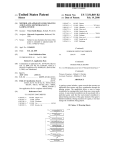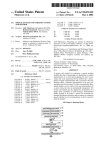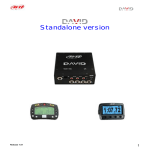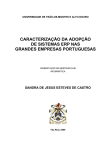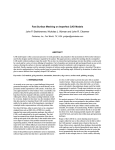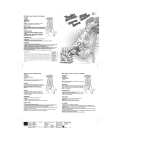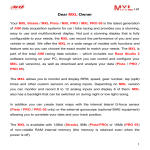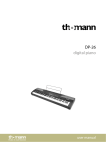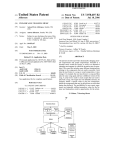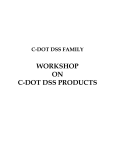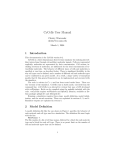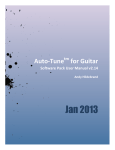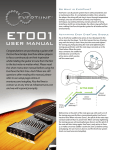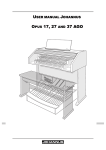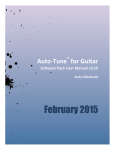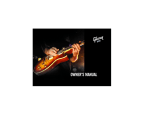Download Music training apparatus
Transcript
US005287789A United States Patent [19] [11] [45] Zimmerman [54] MUSIC TRAINING APPARATUS [76] Inventor: Thomas G. Zimmerman, 218-15 Hartland Ave., Flushing, NY. 11364 [21] Appl. No.: 803,035 [22] Filed: [51] [52] References Cited 3,919,913 ll/l975 .... ... ..... . 4,063,035 12/ 1977 Appleman et a1. 4,273,023 6/1981 . . . . . . .. 3/1983 Esser ....... .. 2/1984 4,580,133 4/1986 Matsuoka et a1. . Warrender .. . .... . 4,969,194 11/1990 Ezawa et a1. Kuhn. Computer Journal, vol. 14, No. 3, Fall 1990, pp. 60-71. Primary Examiner—-Mich_ael L. Gellner ABSTRACT An apparatus to assist the musical instruction of a stu dent including one or more tone sources (e.g., ?ute, human voice, violin) playing monophonically as-inputs, 84/454 means to quantify aural parameters of pitch, amplitude, 179/1 SP duration, and timbre of inputs, means to visually store and represent temporal history of said, means to store 84/470 R 4,429,609 5,070,754 12/1991 User’s Manual, Voicetracker by Fairlight Industries, cover pp. 26, 27 and 43. 84/454 Mercer ................ .. 4,416,182 11/1983 Wise et al. 84/454 179/1 SP 4,321,853 3/1982 Tumblin 4,378,466 Series in Information Sciences, Springer-Verlag, New York, p. 175. [51] Lester et a1. .................... .. 324/79 R Shrader Feb. 22, 1994 Assistant Examiner-P. Stanzione U.S. PATENT DOCUMENTS 4/1975 Date of Patent: Rochelle park, New Jersey, Chapter 12 William B. [58] Field of Search ................ .. 84/470 R, 477 R, 454 3,876,936 5,287,789 “A real-time pitch recognition algorithm for Music Applications”, 1980, Hayden Book Company, Inc., Dec. 6, 1991 Int. cl.5 ............................................ .. G09B 15/02 US. Cl. ........... .. .. 84/477 R; 84/454 [56] Patent Number: . . . . . . .. 84/454 . 340/701 381/48 Adamson ............................ .. 84/454 OTHER PUBLICATIONS “Computer-Aided Speech Training for the Deaf” (Journal of Speech and Hearing Disorders, Feb. 1976, vol. 41-, No. 1), R. S. Nickerson, D. N. Kalikow. Niedzwiecki and Mikiel (1976) Hess, Wolfgang, “Pitch Determination of Speech Signals” vol. 3 of Springer and playback audio signal of inputs, and means to arrive at and display musical related pitches. A waveform analyzer is used to control a tunable low-pass ?lter in the pitch tracker and preform spectral estimation of timbre. Pre-recorded music instruction and a karaoke player are used as examples of reference tone sources. Visual representation of aural parameters can provided as video output. 40 Claims, 7 Drawing Sheets US. Patent Feb. 22, 1994 Sheet 1 of 7 5,287,789 US. Patent Feb. 22, 1994 Sheet 3 of 7 5,287,789 104 131 MCU J< DAC 125 I DOUT 107 AC COUPLED / ‘ZERO HALF WAVE RECTIFTER Um .102 / 1os\ > cRoss DETECTOR |_—'—* LATCH DROOP DETECTOR 105'“ GATE D'N 105 . ‘ ’ -—— DETECTQR —.———> i .52 RESET ’ DOUT 11o ENVELOPE ~1°9 FOLLOWER - * \ ADC m 114 SPECTRAL ~ / 56 ESTIMATOR 5 | PM To 0- X OTHER 1 _ Flg. 3 SPECTRAL 11$ ESTIMATOR 119 117 52 / MCU TONE DECODER Z 11a RCV ?g US. Patent 104 131 219 DAC r ‘5 Sheet 4 of 7 R19 m2 = 130 I INCREASE /221 /zERo cRoss ADC 250 '\ (,‘HI/g = 204 E1 wig:51 \ 1’ 1 I ‘ —> 2° Q1 251 210214 _n___ c2 D2 :l_/ - FILTER AC > 02_/_I>RooI= COUPLED HALFwAvE RECTIFIER 105-’ Q9. r232 212 R15 VLOW - , DROOP DETECTOR 211 271 217 R1 6 ___ / __-S-1-Q1DROOP DIN - 215\ 213 R17 + / 237 /LOW 7 S702 Lew DIN /HIGH _3 Q3 H/IGH DIN 1os-~ 259 " _ 208 209 27 \ ’ /GATE _ 4 04 65“ DIN * GATE DETECTOR 24o I R13 VGATE 111- R'E'sTET R14 ; I 202 C10? R10 Dom O1 114 200 N sPEcTRrAL ESTIMA OR DOUT 236 7 ‘1 203 / 56 CAPTURE INPUT \21s "J2 125 ENVELOPE F°LL°WER DOUT DOUT 205 IC11‘\$"11 R12 \230 D10 LOW PASS ’ 220 _ 107 TUNABLE W CR ASE , \ |I¢12 - "' 5,287,789 D11 )4 103 55 Feb. 22, 1994 x1 PAI x TO 05E: x2 SPECTRAL ESTIMATOR 1 1s M109 110/ Flg. 5 Aoc US. Patent 1401 / (400 \\ Feb. 22, 1994 400 1' Sheet 6 of 7 403 424- ~~-* 5,287,789 42\1 l g” U.S. Patént Feb. 22, 1994 Sheet 7 of 7 5,287,789 502 AUDIO L VCR 11 4s 15 21 i CONTROL / UNIT 501 15 19 511/ =1 ""350 COMPUTER \ 40 510 12 ‘4 1s Flg. 13 507 /s31 50/4’ =1: ) 7 L9 A VIDEO MIXER 503 / KARAOKE 52o\ /41 40 VIDEO :05 PLAYER AUDIO / 1, 506 15 \ LYRICS\ 2 521/ 532 i=1 COMPUTER f '12 15 k" 21 CONTROL UNIT B A+B 13 Flg. 14 5,287,789 1 2 volume of his voice, the accompaniment, and the refer MUSIC TRAINING APPARATUS ence solo voice. Typically students would practice sing ing with the reference solo voice and accompaniment. BACKGROUND OF THE INVENTION After they have learned the words and are comfortable This invention generally relates to a teaching device 5 singing the melody, they turn off the reference solo voice and sing, unassisted, with the accompaniment. to assist music students in recognizing and producing accurate pitch, timbre (tonal quality), and timing (me ter) on their musical instrument and more particularly to an electronic apparatus to quantify and provide vi sual feedback of the musical performance of a student to that of a musical reference. A student of music, for purposes of description, is More elaborate karaoke systems use a laser disk or CD&G compact disk (a format that encodes graphic images with audio) that display song lyrics on a video monitor which change color as each word is sung (anal ogous to “the bouncing ball” technique). Karaoke sys tems do not evaluate the singer’s performance and hence students must rely on their own musical percep anyone who is trying to play a musical instrument. The invention disclosed herewith discusses musical instru tions for guidance. ments that produce a tone of detectable pitch. This 15 Electronic devices exist which visually indicate the includes the human voice, violin, and ?ute and excludes instantaneous absolute pitch and error of a tone source most percussive instruments (e.g., snare drum and tam (e.g., Sabine ST-lOOO Chromatic Auto Tuner, Korg bourine). A tone has aural parameters that include DT-2 Digital Tuner, Arion HU 8400 Chromatic pitch, amplitude, duration, and timbre. When used in Tuner). Mercer US. Pat. No. 4,273,023 discloses a de the context of ‘audible tone reference’, tone can include 20 vice that displays the instantaneous absolute pitch of a any combination of pitched and unpitched sound musical instrument with an array of LEDs arranged on sources (e.g., a band with a percussion section). a musical staff but can only display the pitch of one tone A basic ability required of a student of music is to source at a time. Tumblin U.S. Pat. No. 4,321,853 dis produce and sustain a musical tone of de?ned pitch and closes a system that measures the instantaneous pitch of good timbre. This task is easy on an instrument like a 25 a musical instrument relative to an electronically gener piano which mechanically quantizes pitch and con strains timbre. Singers, however, must dynamically adjust their vocal muscles to control pitch and timbre ated reference tone and displays the difference (the pitch error) on a column of lights. Neither of these systems provide a time history of pitch nor do they based on their aural perceptions. Similarly, violinists provide any quantative indication of timbre or ampli must adjust their bowing and ?ngering based 0 their 30 tude. aural perceptions. ' . The importance of these aural perceptions is demon strated in the dif?culty deaf children have learning to speak. If the internal discernment of pitch and timbre is The system of Nickerson et al. displays a time history of pitch, duration, and timbre but is not well suited for musical instruction. The system uses a miniature accel not developed in an individual, some external feedback 35 erometer applied to the throat with adhesive tape to measure the pitch of the student’s voice. Since the stu is necessary. In their paper titled “Computer-Aided dents are deaf, no consideration for aural reference is Speech Training for the Deaf” (Journal of Speech and made. Data collected is presented in the context of Hearing Disorders February 1976 Vol. 41, No. l), R. S. speech, not music, and no provisions are made for pitch Nickerson, D. N. Kalikow, and K. N. Steven report on a computer-based system that uses visual displays of 40 tracking musical instruments. speech parameters (e.g., pitch, amplitude, and spec trum) to aid speech training for the deaf. In music instruction, a student’s aural perceptions are Producing an accurate static tone is a good start for a music student; however, music is the dynamic organiza tion of sound over time. An accomplished musician needs additional skills to produce a sequence of tones typically developed through collaboration with a music teacher who points out, by verbal comment and audible 45 (playing a melody), match a sequence of tones (playing a melody in key), produce a tone relative to a reference example, the pitch, timbral, and timing errors of the tone (playing an interval), produce a sequence of tones student. Teaching musical skills are complicated by the relative to a sequence of reference tones (playing in fact that sound, unlike paintings, cannot directly be seen harmony), produce tones in a broad range of pitches and only exist when played. Audio tape recorders allow students to review their performances, but do not pro 50 (range), quickly varying the pitch and amplitude (vi vide any analysis. A system of entertainment that offers learn-by-exam ple instruction is the karaoke system popularized in brato and tremolo), produce tones at specific times and durations (playing in meter), and produce tones of good timbre (tone quality). Neither Mercer or Tumblin have the display neces orchestra”) consists of a pre-recorded audio source, a 55 sary to show a time history. Mercer has two pitch track Japan. A karaoke system (literally Japanese for "hollow microphone, audio mixer, ampli?er, and speaker. The ers but lacks any memory means to store the pitch data. audio source material, typically a compact or laser disk Street, Long Beach, Calif. 90810), is specially prepared Tumblin has music exercise data stored but only has one pitch tracker and does not store the pitch data. Tumblin uses music exercise data that must be speci?cally pre support for the singer. The accompaniment is usually a band-or orchestra but could simply be a piano, other Much work has been done developing the art of pitch (LaserKaraok ® Pioneer LDCA, Inc., 2265 East 22th with musical accompaniment on one channel and a solo 60 pared for his invention. This requires the production, marketing, and distribution of music exercise data. vocal reference on the other. The musical accompani Pitch tracking is the dynamic determination of the ment can be any musical instruments that provide tonal fundamental frequency of an applied audio signal. vocalists, or a guitar. The reference channel is typically 65 tracking for speech recognition. Niedzwiecki and the solo voice of a trained singer, or a solo instrument like a clarinet or monophonic synthesizer. The karaoke system allows the singer to independently adjust the Mikiel (1976) (Hess, Wolfgang “Pitch Determination of Speech Signals” Volume 3 of Scringer Series in Informa tion Sciences. Springer-Verlag, New York, page 175) 5,287,789 3 report of a pitch tracker using a tunable low-pass ?lter’ 4 errors are, and comply with the interests and pace of each individual student. whose cutoff is dynamically adjusted by the amplitude of the output signal. If a signal is present at the output, the cutoff frequency is lowered until the amplitude of the output goes down. Ideally the adaptive operation of this system would dynamically maintain the cutoff fre quency of the ?lter slightly above the fundamental fre-' quency of the applied audio signal. In addition to the It can be seen, therefore, that a need exists for a music training apparatus that can provide a student with an accurate temporal visual record of aural parameters of their musical performance and of a musical reference. SUMMARY OF THE INVENTION reported problem of tracking performance being depen A principal object of the invention is to provide train dent on input signal level, it has been found through m 0 ing, assistance, and guidance to music students in the experiment that the output signal may produce noisy development of musical skills. tracking results due to its small signal to noise ratio. The systems of Mercer and Tumblin rely on pitch trackers that require one and only one peak per pitch cycle and an amplitude envelope that does not ?uctuate Another object of the invention is to allow music students to visually monitor temporal representations of musical parameters of their musical performance and a musical reference. A further object of the invention is to be compatible rapidly. For example, when upper harmonics (over with a wide range of musical reference sources. tones) of a resonant low-pitched male voice are rein forced as they fall within the frequency range of for Another object of the invention is to provide a pitch tracker capable of determining the pitch of a wide range mants (the natural resonance frequencies of the vocal 20 of monophonic audio inputs. track), multiple peaks can occur. A musically trained listener can detect pitch errors as Another object of the invention is to provide a simple small as 0.3%, a deviation of about one cycle per second and inexpensive means to measure the timbre of an for an A4 (440 Hz). The accuracy and stability of a pitch tracker is therefore very important in a music training audio signal. system. , Another object of the invention is to provide a means 25 to practice intonating intervals, assisted by a temporal Timbre refers to the tonal quality of a musical instru ment, the combinations of overtones that give each instrument its unique sound. The “nasal” quality of a voice and the “scratchy” sound of a violin are all refer ences to timbre. Fourier analysis is one technique to 30 quantify timbre by measuring the energy in the compo nent frequencies of a sound source. The analysis, how ever, requires numerous computations and is time con suming. Nickerson et al. use a bank of 19 ?lters to deter mine spectral content of the deaf student’s voice. An 35 analog electronic implementation of such a ?lter bank would require many parts that occupy circuit board history of visual representations of aural parameters. A further object of the invention is to provide a means to practice intonating melodies, assisted by a temporal history of visual representations of aural pa rameters. In order to accomplish these objectives, the invention comprises a means to provide a monophonic reference source, a means to objectively and accurately quantify the aural parameters of pitch, duration, amplitude, and timbre of student intonations and that of the monopho nic reference source, a means for digitally storing said parameters, a means for visually representing a tem space, undesirable in a portable unit, and would have an poral history of said parameters, a means for providing impact on manufacturing time and cost. A digital imple reference aural parameters, a means for determining and mentation would require signal processing capabilities 4-0 visually representing musical intervals of the monopho with associated speed requirements and cost. Both ap proaches produce an abundance of data that must be further processed in order to be interpreted. A pre nic reference source, a means for digitally recording and playing back an audio signal, a means for providing audible tone reference, and a means for providing musi ferred analysis technique would require few compo cal instruction. A monophonic reference source is the musical perfor nents, have a low cost, and produce results that are easy 45 to interpret. mance the student is striving to emulate. The perfor It is helpful for a student of music to see several notes mance may be as simple as matching a single pitch, in advance in order to plan playing technique necessary to shape musical phrases. None of the musical system mentioned display tones in advance of being heard. singing intervals to a pitch, or as complex as singing an entire opera. The monophonic reference source con tains a sequence of one or more aural parameter which Of the numerous musical instruments a student might include pitch, timbre, amplitude, and duration. Mono want to learn, singing is often the most psychologically phonic reference sources include a live or recorded series of tones produced by such sources as a human difficult for those adults who were told as children that they could not sing. These adults are often reluctant to voice, musical instrument, or electronic device. The attempt singing in front of others for fear of judgement. 55 monophonic reference source need not be audible. The Singing is a skill, like reading, that needs to be devel sequence of aural parameters (a “note event list”) may oped by instruction and practice. Individual instruction be provided as data organized on media such as mag is often necessary, for each student’s errors and progress netic disk, tape, or computer memory. A note event list is a chronological record of pitch, and duration of a are unique. Typically vocal instruction requires ?nding a music teacher, arranging a visitation schedule, paying 60 musical performance. A piano roll is an example of a for the classes, and maintaining regular attendance. note list recorded on paper. Note lists can also be cre These factors can discourage potential music students from pursuing instruction. An ideal music instructor would be available anytime, anywhere, would have ated by playing on a synthesizer and having a computer record the key strikes (“note events”). Libraries of pop in?nite patience, be consistently accurate, non-judg mental, could be shared among several people for no additional cost, provide instruction on any of a thou sand popular songs, show exactly where a student’s ular and classical songs stored as note event lists are 65 commercially available (e.g., Music Productions, Inc., PO. Box 22681, Milwaukee Oreg. 97222-0681 or Pass port, 625 Miramontes Street, Half Moon Bay, Calif. 94019). Commercial note event lists are commonly ar 5 5,287,789 ranged as orchestrated pieces of music with several parts (“tracks”) occurring simultaneously. Such note event lists are used as monophonic reference sources by designating one track as the melody and the rest as accompaniment. This designation can either be ascer tained from the manufacture, or discovered by trial. Once designated, the host computer 13 can retain this information to relieve the student of any further con cern over track designation. The means of reading a note event list with a computer and sending note event commands to a synthesizer have become greatly simpli ?ed with the adoption of the MIDI (Musical Instrument Digital Interface) standard, is well known to those skilled in the art, and need not be covered here. Student intonations are monophonic tones produced or caused by the actions of the student, including sing ing and playing a musical instrument. Student intona tions are received and converted by a pickup device, 6 The audible tone reference provides a guide to assist students in their musical performance and may be a sequence of singular tones (“monophonic”) or a plural ity of tones (“polyphonic”). Sources of audible tone reference include live and recorded human voices, mu sical instruments, and electronic tone generators. The audible tone reference can be as simple as a solo human voice, or as complex as a full orchestra. The monopho nic reference source may serve as the audible tone refer ence. If the monophonic reference is inaudible (as with a note event list) a means such as an electronic tone generator may be used to express the tone of the aural parameters. Several ?rms (e.g., Pocket Songs, 50 S. Buckhout Street, Irvington, N.Y. 10533, SongTraxTM by Song tech, 3900 E. Whiteside Street, Los Angeles, Calif. 90063) provide pre-recorded popular music in a format (“multiplexed format”) that separates a solo instrumen such as a microphone or electromagnet, into an electric 20 tal performance from an accompaniment (as in the ka signal applied to the invention. raoke system). Typically a stereo tape recording is pro The pitch of a monophonic tone source is determined by a pitch tracker. In a preferred embodiment of the invention the upper harmonics of a tone source are attenuated by a tunable low-pass ?lter and applied to a zero cross detector. The cutoff frequency of the low pass ?lter is dynamically determined by analyzing fea tures of the output waveform of the low-pass ?lter. The pitch durations of the tone source may be determined by detecting abrupt changes in the frequency, ampli tude, and/or spectrum of the tone source. In a preferred embodiment, a ?xed amplitude threshold is used to detect duration, an envelope follower is used to detect amplitude, and counting the number of times the slope of the tone’s waveform changes sign is used to deter mine timbre. Said means to detect pitch, amplitude, duration, and timbre are used in a preferred embodi ment to determine the aural parameters of student into nations and that of audible monophonic reference sources. The absolute pitch of a musical interval is based on a musical scale built on a reference pitch (“tonic”). In a vided with a solo vocal performance on the right chan nel and a band playing accompaniment on the left chan nel. This multiplexed format can provide both the audi ble tone reference and monophonic reference source. In one embodiment of the invention the solo vocal channel is used as the monophonic reference source, and the combination (audio mix) of both channels is used as the audible tone reference. The means for providing musical instruction may be any recorded material that guides the student. This may include written material (e.g., a text or workbook), text and/or graphics on a visual display, audible material on a compact disk, vinyl record, or audio tape, and mate rial digitally stored in RAM, ROM, optical disk, or magnetic media. For example, the recorded material may guide the student by providing an audio reference of a properly played instrument (e.g., a karaoke record ing) or by providing a syllabus of instruction on applied music theory (e.g., a lecture on scales and intervals with musical examples). ' In a preferred embodiment of the music training sys tem, an audio tape recording of a vocal instructor pro monophonic reference source. Intervals may be visually vides both the source of musical reference and musical represented in many forms. In one embodiment inter 45 instruction. The audio tape contains vocal exercises that vals appear as horizontal lines, vertically positioned by preferred embodiment the tonic is provided by the pitch. In one embodiment aural parameters are digitally stored in random access memory (RAM) by the opera tion of a microcontroller unit (MCU). Aural parameters from one or more sources may be visually represented are used with the invention to practice such exercises as . holding a steady tone, singing in meter (proper rhythm), singing a melody, and singing harmonies. The audio - tape contains verbal descriptions of each exercise, into nations by the instructor, complete songs with vocal and musical accompaniment, and encoded commands to automatically control functions of the invention. The display screen simultaneously shows a temporal visual plotted in logarithmic units along the vertical axis and time in linear units along the horizontal axis. Each 55 representation of aural parameters of the student and the instructor. A preferred visual representation of tone source of aural parameters is represented by a line of sources are graphic plots where the vertical axis is pitch unique brightness whose thickness represents amplitude (in logarithmic units), horizontal axis is time, line thick and color represents timbre. ness is amplitude, line color is timbre, and line bright The means to record and playback audio signals digi in a variety of ways. One embodiment visually repre sents aural parameters on a graphic display with pitch tally are well known to those skilled in the art (see Hal 60 ness is used to distinguish multiple tone sources. - Chamberlin, Musical Applications of Microprocessors, 1980, Hayden Book Company, Inc., Rochelle Park, NJ. In a preferred embodiment instruction in singing intervals and harmonies is provided by displaying musi cally related pitches (e.g., third, fifth and octave) to a reference pitch from the monophonic reference source. chapter 12). In one embodiment the tone source is low pass ?ltered to prevent aliasing and sampled at regular intervals with an analog-to-digital converter (ADC). 65 The display speed can be increased to disclose precise pitch contour, revealing such features as vibrato, pitch The digital samples are stored in RAM and played back through a digital-to-analog converter (DAC) followed sustaining accuracy, and note approach (e.g., overshoot by a low-pass ?lter to remove sampling artifacts. or undershoot). 5,287,789 7 DESCRIPTION OF THE DRAWINGS FIG. 1 shows a perspective view of the invention 8 ronment can be reduced by using a directional-type microphone. The stereo audio tape 16 contains two channel, (a) the accompaniment channel which contains verbal instruc FIG. 2 illustrates schematically, by means of a simpli 5 tions for the student and musical accompaniment (e.g., a ?ed block diagram, the electronic components of the piano) and b) the monophonic reference channel which present invention. contains intonations of the vocal instructor and encoded FIG. 3 illustrates schematically, by means of a simpli~ commands to control functions of the invention. tied block diagram, the waveform analyzer. In order to understand some of the functions of the FIG. 4 illustrates schematically, by means of a simpli invention, some musical terms must be introduced. A tied block diagram, the command tone decoder. tone is an audible sound that has pitch, timbre, duration, FIG. 5 illustrates a circuitry detail of the waveform and amplitude. An interval is the frequency relationship analyzer. between two pitches. A scale is a series of pitches that FIG. 6 illustrates by means of waveforms the opera are related by speci?c intervals. A note is any pitch of a tion of various circuits in the waveform analyzer. 15 scale. The tonic is the ?rst note of a scale. A harmony is FIGS. 7 to 12 illustrate visual representations of aural two notes played together. A melody is a sequence of parameters used in the preferred embodiment of the notes. A harmonic melody is a sequence of harmonies. invention. ‘ A common scale in Western music is the major scale illustrating the basic system components. FIG. 13 illustrates schematically, by means of a sim which contains 7 pitches. A chromatic scale is a se pli?ed block diagram, an application cf one embodi 20 quence of 12 pitches based on the interval the twelfth ment of the invention that records on video tape the performance of a student. root of two. A pitch that is not equal to any note of a » scale is called an accidental. If the pitch is not exactly FIG. 14 illustrates schematically, by means of a sim equal to any note of the chromatic scale, it is considered pli?ed block diagram, an application of one embodi out of tune and is described as being sharp or flat ment of the invention that produces a superimposed 25 (higher or lower in frequency) relative to the nearest image of a karaoke player’s video output with a tem note of the chromatic scale. Three common intervals poral visual representation of the singer's aural parame are the third, v?fth and eighth. These refer to the third, ters. fifth and eighth note of the scale. The eighth note is an octave interval, twice the frequency of the tonic. The . DESCRIPTION OF PREFERRED 30 pitch of the tonic must be known in order to determine EMBODIMENTS an interval. For purposes of explanation and simplicity the inven Since intervals are ratios, musical calculations are tion will be described in the context of voice instruction best done in logarithmic units. Logarithmic units of using the intonations and speaking voice of a pre pitch are semitone and cents (hundredths of a semitone). recorded vocal instructor as the monophonic reference 35 A semitone is the interval the twelfth root of two. There source, audible reference, and musical instruction. are twelve semitones per octave. Each semitone is the Other sources of musical reference and instruction may pitch of a note of the chromatic scale. An interval is be used without deviating from the spirit of the inven determined by calculating a chromatic scale based on tion. the tonic pitch and adding the number of semitones that A perspective view of the invention 10 can‘be seen as correspond to the desired interval. For, example 4 semi~ set forth in FIG. 1. The four main components are a headset 11, a control unit 12, a host computer 13 and a video monitor 41. The headset 11 contains a micro tones are added for major third interval, 7 semitones are added for a perfect ?fth interval. At all times, whenever the student sings, the student phone 14 to pick up student intonations and headphones hears his voice on the headphones 15 and sees a tem 15 for the student to monitor his voice and recorded 45 poral visual representation of his voice’s aural parame material. The control unit 12 contains an instructional ters on the display screen 22. The control unit 12 con audio tape 16, a stereo audio tape player 17, various tains various switches 18 that, when pressed, perform control switches 18', a connector 19 for the headset 11, the following functions: and a serial communication output 20. The control unit PLAY 23. The audio tape 16 plays. The student hears 12 sends aural parameters to the host computer 13 over 50 recorded material from audio tape 16 along with his the serial communication line 21. The host computer 13 voice on the headphones 15. The student sees a visual receives aural parameters and generates a video signal representation of aural parameters of his voice and the 40 that contains a visual representation of the aural monophonic reference channel on the display screen 22. parameters. The video signal 40 is sent to a video moni REWIND 24. The audio tape 16 rewinds to review tor 41 and viewed on the display screen 22. The host 55 past material. computer 13 is used as a display driver for the video FAST FORWARD 25. The audio tape 16 advances monitor 41 to decrease the cost of the invention 10 for to new material. ' someone who already has a computer (e.g., an IBM PC LOOP 27. The audio tape 16 stops. The student hears or Apple Macintosh). However, it is not required and the most recent history of the instructor’s intonation, both the host computer 13 and video monitor 41 may be digitally replayed in an endless loop, and sees aural replaced with a portable display (e.g., a liquid crystal) parameters of student’s and instructor's intonations on and appropriate control electronics to make a compact, the display screen 22. Alternate presses terminate the battery powered, portable version of the invention. LOOP function. The headphones 15 prevent sound from the audible STOP 26. The audio tape 16 stops. The LOOP func tonal reference and accompaniment source from reach 65 tion (if on) stops. ing the microphone 14, which would otherwise add additional frequencies and noise that could result in pitch tracking errors. Extraneous noise from the envi SHOW INTERVALS 28. Musical intervals (e.g., third, ?fth, octave) related to a tonic are visually repre sented on display screen 22. When the SHOW INTER 5,287,789 9 10 VALS switch 28 is pressed, the current pitch of the as follows: DIN=data in; DOUT=data out; ADC monophonic reference source is saved and used as the =analog-to-digital converter; RCV=serial TX =serial out; PAI =pulse accumulator input. tonic. If no pitch is present on the monophonic refer ence channel when the SHOW INTERVALS switch 28 is pressed, the previously stored tonic is used. Suc cessive presses of the SHOW INTERVALS switch 28 toggle the function on and off. I SHOW HARMONY 29. Harmony pitches are dis played (e.g., third, ?fth and octave) for each monopho in; Audio lines 47 and 48 from the output of the audio tape player 17 are routed through a channel switcher 51, a double-pole single-throw switch set by the control SWITCH CHANNEL 31. This allows either output line 47 or 48 of the audio tape player 17 to be treated as nic reference pitch. The tonic is determined by the same a monophonic reference signal 52, and the alternate as an accompaniment signal 63. technique used in SHOW INTERVALS. Successive presses of the SHOW HARMONY switch 29 toggle command tone decoder 53 which detects the presence this function on and off. - DISPLAY SPEED 30 changes the time (horizontal) scale of the display screen 22. A fast display speed re veals details of pitch trajectory, for example vibrato depth and speed, pitch stability, and reference pitch approach. A slower display allows more pitches to be displayed on the display screen 22. SWITCH CHANNEL 31. This switch reverses the output of the stereo tape player 17. This function allows either channel of a stereo audio tape 16 to be treated as the monophonic reference source. REFERENCE VOLUME 32. This control varies The monophonic reference signal 52 is applied to a of a high frequency marker tone (e.g., 10 kHz) used to encode commands in the monophonic reference signal 52. A low-pass filter 54 removes the marker tone from the rest of an audio path 55. The ?ltered monophonic reference signal 55 is applied to a waveform analyzer 56, a multiplexer 57, and an audio mixer 59. The wave form analyzer 56 extracts the aural parameters pitch, amplitude, duration, and timbre. An audio digitizer 58 converts a continuous audio signal 99 into digital sam ples 60. The multiplexer 57 selects an audio signal 55 or 63 to be digitized, typically the monophonic reference signal 55. The audio mixer 59 combines the monophonic the volume of the monophonic reference channel heard 25 reference signal 55 with other audio signals, the sum of ' which are ampli?ed by an audio ampli?er 61 and heard ACCOMPANIMENT VOLUME 33. This control on the headphones 15. varies the volume of the accompaniment channel of the The multiplexer 57 is normally set by a control line 62 tape player 17 heard on the headphones 15. of the MCU 50 to select the monophonic reference on the headphones 15. MIC VOLUME 39. This control varies the volume 30 signal 55 as the source to be digitized. The audio tape 16 of the student’s voice heard on the headphones 15. can instruct the MCU 50, through a tone encoded com MASTER VOLUME 35. This control varies the mand detected by the command tone decoder 53, to set combined volume of all audio signals applied to the the multiplexer 57, through the control line 62, to select q The particular intervals and harmony, or alternative 35 the accompaniment signal 63 as the source to be digi tized. The multiplexer 57 may also be set manually, for scales (e.g., pentatonic or other non-Western scales) can example by switch (not shown). There are cases when be preset, selected by encoded tone on the monophonic the multiplexer 57 would be set to digitize the accompa reference channel, or manually set by additional niment signal 63, such as when the monophonic refer switches (not shown). In some cases it might be difficult ence signal 55 contains the reference aural parameters to set the tonic as described, as in the case of pre but not the audible tone reference. In one embodiment recorded songs. The tonic may also be set by manual the monophonic reference source is a recording of tones switches (not shown). For example two switches could of steady pitch and constant timbre and amplitude (e.g., respectively increment and decrement the tonic in semi from a synthesizer) which produces correspondingly tone increments and the selected ‘tonic (e.g., C sharp) headphones 15. 45 consistent visual representations used as a model of an could be viewed on the display screen 22. idealized singer. The monophonic reference pitches Further controls may be provided to tune and trans would sound irritating (i.e., “machine-like") due to their pose the audible tone reference when provided by a aural consistency so an audible tone reference of a per tone generator under control of the invention. A simpli?ed block diagram of the control unit 12 is set forth in FIG. 2. A microcontroller unit 50 (MCU) (68HCll-Family Microcontroller, Motorola Inc. Mi crocontroller Division, Austin, Tex. 78735) is used to perform much of the control functions of the invention son singing is provided on the accompaniment channel. The two channels are synchronized so that each tone occurring on the monophonic reference channel corre sponds to a tone on the accompaniment channel. The microphone 14 converts the voice of the student into an electric signal 71 that is ampli?ed by an audio log-to-digital converter (ADC), electrically erasable 55 pre-ampli?er 64 and applied to a waveform analyzer 65 and the audio mixer 59. The waveform analyzer 65 is read only memory (EEPROM), random access memory identical to waveform analyzer 56. The gain of the (RAM), read only memory (ROM), serial communica 10. Although this microcontroller with its built in ana audio pre-ampli?er 64 may be adjusted by the student tion interface (SCI), 16-bit timer and pulse accumula (not shown) to compensate for variations in microphone tion circuit (PAC), provide for a highly integrated, small, inexpensive, and low power implementation of 60 14 sensitivities and strength of the student’s intonations. An indicator lamp (not shown) may be included to indicate when gain of the audio pre-ampli?er 64 was too high (i.e., the amplifier has reached its maximum output and is distorting). The MCU 50 decodes commands from the tape The function of many of the pins on the 68HCll are 65 player 17 by monitoring the output of the command software con?gurable so their designated names do not tone decoder 53. The MCU 50 also receives commands always disclose their function. For clarity, pins on the from the front panel control switches 18. MCU 50 have been renamed according to their function the invention 10, it is not required and may be replaced with other electronic circuitry or software. For simplic ity, however, the invention will be descried using the microcontrol unit (MCU) 50 as the controlling device. 5,287,789 11 The MCU 50 saves the most recent samples of digi 12 reference aural parameters are stored in the host com puter 13. The LOOP command instructs the host com tized audio (e.g., the last 8 seconds worth) from the audio digitizer 58 in RAM 67. The most recent samples of aural parameters from the waveform analyzers 56 puter 13 to maintain the temporal display of the most recent segment (“looping segment”) of monophonic and 65 are saved in the host computer 13. When the reference aural parameters and update student aural parameters, while the MCU 50 plays back the last sev LOOP switch 27 is pressed by the student, the MCU 50 stops the audio tape player 17 and sends the last several seconds of digitized audio samples, in a continuous eral seconds of audio material. The result is the student sees and hears an unchanging segment of the most re cent .history of the monophonic reference source re _ endless loop, to the DAC 68. The DAC 68 converts digital signals 73 into an audio signal 69 that is mixed with the voice of a student 72 by the audio mixer 59, ampli?ed by the audio ampli?er 61, and heard on the peated endlessly along with an updating display sweep of his intonations. The time duration of the looping segment (“looping time”) is dependent on the display _ student’s headphones 15. For simplicity the combined speed-the faster the display speed, the shorter the looping time. The looping time and the corresponding audio signal 4-6 is considered a monophonic sum of all the audio signals applied to the audio mixer 59, and heard equally on each headphone 15 of the headset 11. It is understood that additional controls commonly monophonic note events included in the looping seg ment is speci?ed by the LOOP IN MARKER and LOOP OUT MARKER. The loop in time speci?es where in the monophonic reference note event list the occurring on audio mixers would provide a stereo out put with individual spacial placement (pan or balance looping segment begins, and the loop out time speci?es control) for each of the audio inputs to the audio mixer 20 where the looping segment ends. When the LOOP 59. switch 27 is pressed the loop out time is set to the system The MCU 50 continually reads and controls the clock. The display period is the time it takes aural pa waveform analyzers 56 and 65. The MCU 50 processes rameter data to scroll completely across the screen, The the output of the waveform analyzers 56 and 65 and loop in time is calculated as the loop out time minus the sends quantized values of aural parameters to the host 25 display period. The loop in and loop out times are sent computer 13 through display commands and data, sent to the host computer by the LOOP IN MARKER and over a serial communication line 21. The host computer LOOP OUT MARKER commands respectively. These 13 runs a display program that converts display com times may be'adjusted to allow a particular section of mands and data into visual representations and outputs the looping segment to be repeated. The loop in and a video signal 40 to the display screen 22. A partial list loop out times may be independently and continuously of representative display commands with description adjusted, for example, by two slide potentiometers (not and data (if any) are set forth in Table 1, below. TABLE 1 shown) read by two of the MCU 50 analog-to-digital Command Description Data DRAW TONE Plots aural parameters aural parameter source, LOOP Activates loop function CLEAR SCREEN SHOW STAFF Clears the screen Draws musical staff pitch, amplitude, time stamp SET SPEED Sets speed of display SHOW MAZE Draws maze Sl-IOW INTERVAL SHOW HARMONY LOOP IN MARKER LOOP OUT MARKER Plots interval bars aural parameter source, tonic Plots harmony bar Loop begin time aural parameter source, toni time stamp Loop end time time stamp Several commands specify the aural parameter source since the invention can analyze and display aural parameters of multiple sources (e.g., student intonation and monophonic reference source). The DRAW 50 ports, or adjusted in increments of monophonic refer TONE command contains a time stamp which specifies the absolute time of aural parameter occurrence. The host computer 13 uses the time stamp to locate the ence note events by push buttons. A note event list is a complete record of every note with its associated aural parameters occurring in a piece , position (X axis) of aural parameters on the display of music. One feature of the invention is the display of screen 22. The time stamp is derived from a system time 55 aural parameters of notes in advance of student intona clock maintained by the MCU 50. The aural parameter tion. Looking ahead in a musical score at upcoming duration is not sent in the DRAW TONE command for notes, allows a musician to phrase a series of notes (e.g., it is apparent in the temporal nature of the display build up volume to a crescendo), identify rhythmic screen 22 (i.e., the duration of an aural parameter is seen patterns, view lyrics (as can be coded in a note event as its horizontal length). The SHOW INTERVAL and 60 list), and otherwise prepare his instrument (e.g., breath SHOW HARMONY commands specify the tonic of the scale to be used for calculating interval and harmony ing for a vocalist, placing a bow for a violinist). The block diagram of electronic circuitry as set forth in FIG. 3, details the waveform analyzer 56 which pitches. The LOOP function plays out a digital recording of sampled audio visually represented on the display screen 22. In one preferred embodiment the last several seconds of audio material are saved by the MCU 50 in RAM 67 and the most recent segment of monophonic 65 quanti?es the aural parameters of pitch, amplitude, du ration, and timbre of the applied audio signal 55. The waveform analyzers 56 and 65 are identical and differ only in the signals that enter and leave them. Therefore only waveform analyzer 56 will be examined. 5,287,789 13 14 The pitch of the applied audio signal 55 is determined by measuring the period of its fundamental frequency. tracted from the solo vocal performance and the stu dent monitors both the solo vocal and accompanying The period is detected by a zero cross detector 102. The band for a tonal reference. The con?guration of case 3 fundamental frequency is extracted from the audio records a pure tone with steady pitch, constant timbre source 55 by a tunable low-pass ?lter 103. The cutoff 5 and amplitude on the right channel and a combination frequency of the tunable low-pass ?lter 103 is deter (audio mix) of solo vocal and accompanying band on mined by a control input 130 voltage set by a digital-to the left channel. This con?guration produces a visual representation of an ideal performance. The pure tone is analog converter 104 (DAC). The MCU 50 adjusts voltage output 131 of the DAC 104 based on the output typically annoying to listen to due to its lusterless con of a droop detector 105 and a gate detector 106. The sistent nature, so the left channel provides a mix of solo vocal and band as a tonal guide to the student. Case 4 droop detector 105 indicates the amplitude and ten dency of an applied waveform 107 to make more than uses a live musical instructor playing along with the two zero crossings during a pitch cycle, which would result in a pitch tracking error. The gate detector 106 indicates when the amplitude of the applied audio signal student. For example a singing teacher would sing along with the vocal student. The teacher and student each require a waveform analyzer, $6 and 65 respec 55 exceeds a ?xed threshold. A latch 108 stores the tively, and a headset 11. In case 5 the monophonic refer momentary output of the droop detector 105 and gate ence source is a note event list of aural parameters digi tally stored on a ?oppy disk. Since the monophonic An envelope follower 109 tracks the amplitude of the reference source is inaudible, note events are sent by the applied audio signal 55 and is read by an ADC input 110 20 MCU 50 or host computer 13 to a synthesizer (not detector 106 and is read and reset by the MCU 50. of the MCU 50. A spectral estimator 11 detects changes in the slope of the waveform of the applied audio signal shown) which provides the audible tone reference. formed based on the selection of storage technique, desirable to have the visual display of reference aural When note events are used as the monophonic refer 55. The output of the spectral estimator 111 is counted ence source, the displayed aural parameters of the monophonic reference source can lead, lag, or be in by a pulse accumulator input 114(PAI) of the MCU 50. Different con?gurations of the invention 10 may be 25 unison to the audible tone reference. Typically it is monophonic reference source and audible tone refer. parameters lead the audible tone reference so the stu ence. Several embodiments are presented as set forth in dent can look ahead to upcoming notes. For the case of a digitally stored note event list (case 5 of Table 2), one Table 2, below. TABLE 2 , STORAGE MEDIA MONOPHONIC REFERENCE WAVEFORM ANALYZER AUDIBLE TONE REFERENCE 1 2 3 audio tape audio tape audio tape note events (R) solo vocal (R) pure tone (R) NO YES YES solo + band (L) solo (R) + band (L) solo + band (L) 4 none teacher YES teacher 5 floppy disk note event list NO synthesizer CONFIG Nomenclature: (R) = right channel of audio tape source (L) = left channel of audio tape source All these con?gurations use a waveform analyzer 65 to extract aural parameters from student intonations. The heading CONFIG refers to the con?guration em software implementation would have two pointers reading out of the note event list. One pointer would bodiment. The heading STORAGE MEDIA refers to 45 select note events to be displayed, the other pointer would select note events to send to the synthesizenThe an example of media on which the information (e.g., offset of these two pointers would detemiine how far monophonic and audible tone reference) can be stored. ahead the display was from synthesizer intonations. For Audio tape can be replaced with any media capable of the case of note events tone encoded on an audio tape storing two channels of audio (e.g., L.P., compact disk, D.A.T., laser disk). Floppy disk can be replaced with 50 (case 1 of Table 2), one implementation would have the audio tape prepared with the tone encoded note events any media that can store digital information (e.g., RAM, leading the audible ton events. The host computer 13 ROM, optical disk, hard disk). The heading MONO could be informed of the magnitude of the offset PHONIC REFERENCE refers to the source of the monophonic reference. The symbols (R) and (L) refer through a tone encoded command to the right and left channel of the audio tape. These 55 assignments are arbitrary and are used to indicate chan nel allocation. The heading WAVEFORM ANALY ZER indicates whether the con?guration requires a second waveform analyzer 56 to extract aural parame ters from the monophonic reference. The heading AU DIBLE TONE REFERENCE indicates the source of the audible tones the student hears as a tonal guide. In case 1 tone encoded note events are stored on the When a note event list is used as the source of aural parameters and the audible tone reference does not occur on the accompaniment channel, some other source of audible tone reference is needed. As previ ously mentioned this could be a synthesizer or a com 60 puter based tone generator. The MCU 50 may also be used as a tone source. For example, the MCU 50 can generate tones by reading a wavetable stored in mem ory and send samples out to a DAC (see Musical Appli cations of Microprocessors, chapter 13). A more basic right channel of an audio tape. An audio mix of solo vocal and accompanying band is provided on the left 65 tone generator is available in the MCU 50 by con?gur ing the internal timer to generate a periodic rectangular channel to guide the student. Case 2 may be used with wave. The duty cycle of the rectangular wave may be commercially available music recorded in the multi varied to alter the perceived volume and timbre. plexed format. Reference aural parameters are ex 15 5,287,789 16 The block diagram of electronic circuitry set forth in MCU 50. The single PAI 114 is shared by the two FIG. 4 details the command tone decoder 53 which detects the presence of a command tone on the applied waveform analyzers 56 and 65 through the multiplexer 113. Referring to FIG. 6A and 6B, waveform 300 and 301 audio signal 52. The monophonic reference signal 52 is a composite audio signal that contains a monophonic reference represent the audio signal 55 applied to the spectral estimator 111 of the vocalized sound “00” and “ee” respectively. These two sounds have different timbre. The “00” sound has less energy in the upper harmonics and is perceived as having a more of a ‘pure tonal qual ity’ as compared to the “ee” sound which has more of a source and tone encoded commands for the MCU 50. There are several techniques of communicating data over an audio channel known to one skilled in the art such as frequency and amplitude modulation. The pre ‘nasal’ sound. In some styles of singing (e.g., choral) the former is preferred. Waveform 302 and 303 represent ferred embodiment uses the presence and absence of a ?xed high frequency command tone (e.g., 10 kHz) to encode‘a standard asynchronous serial data format (e.g., the low-passed version occurring at the inverting input Electronic Industries Association interface standard RS232-C). Referring to FIG. 4, the composite audio 202 of the comparator 203. Waveform 304 and 305 represent the output of the comparator 203. The vowel signal 52 is applied to the high-pass ?lter 115 that atten uates all frequencies lower than the command tone. The “ee” contains more energy in upper harmonics than the _ rameters of the monophonic reference source), provide an internal register and a software interrupt to be gener vowel “00”, as seen by the greater numbers of ripples ?ltered signal 116 is applied to a tone decoder 117 appearing in waveform 301 as compared to waveform whose output 118 goes low when the command tone is 300. This is seen by the greater number of transitions present. The output 118 of the tone decoder 117 is ap 20 occurring in waveform 305 as compared to waveform plied to the serial receive input (RCV) 119 of the MCU 304. 50. A.C. Coupled Half-Wave Recti?er 125: Referring to A preferred embodiment of the tone decoder 117 uses FIG. 5, the post-?ltered audio signal 230 is a.c. coupled an LM567 (e.g., National Semiconductor, 2900 Semi by capacitor C11 to remove any d.c. bias, half-wave conductor Drive, Santa Clara, Calif. 95051) described 25 recti?ed by diode D10, and attenuated by the resistor in the Linear Data Book 1988 edition Volume 3 page divider of R11 and R12 to reduce the maximum nega 5-62 to 5-67. A preferred embodiment of the high-pass tive voltage of the resulting signal 107 to the rating of ?lter 115 is a two-pole high-pass ?lter (not shown) the comparators 204, 210, and 211 (e.g., -0.3 volts for taught on page 175 of Don Lancaster’s book Active-Fil the National Semiconductor LM324). rer Cookbook (Howard W. Sams & Co., Inc. 4300 West 30 Zero Cross Detector 102: The zero cross detector 102 62nd St., Indianapolis, Ind. 46268). is a comparator 204 whose output 205 is high when the Many functions, features, and data can be encoded in post-?ltered audio signal 107 goes above ground. Refer the tone commands. The tone commands can be viewed ring to FIG. 6C, waveform 107 represents the audio as a way of providing additional programming for the signal applied to the zero cross detector 102. Waveform MCU 50. It is possible to load operating code for the 35 205 represents the output of the zero cross comparator MCU 50 over the reference channel using tone encoded 204. When the input waveform 107 is above the ground commands. Some of the uses of the tone encoded com reference 308, the comparator 204 output 205 is low. mands are; turn functions on and off (e.g., loop, interval, The zero cross detector’s output 205 is applied to the harmony), set the tonic, display characters and text on capture input 207 of the MCU 50. A rising edge on the display screen 22 (e.g., words to songs, instructions), 40 capture input 207 causes the value an internal free run point to items on the display screen 22 (e.g., aural pa ning high speed counter (e.g., l MhZ) to be latched into a note event list, provide lyrics and display reference ated inside the MCU 50. An interrupt routing in the aural parameters in advance of hearing the audible tone MCU 50 reads the internal register and calculates the reference. 45 period of the applied signal 107 by subtracting the Referring now to FIG. 5, the detailed operation of latched value from the previous latched value. Fre each section the waveform analyzer 56 will be exam quency is the reciprocal of period. Since our ears per ined. ceive pitch logarithmically, a preferred embodiment of Spectral Estimator 111: The timbre of the applied the invention converts period into the logarithmic fre audio signal 55 is estimated and quanti?ed by counting 50 quency units of semitones and cents (hundredths of a the number of times the slope of the waveform changes ' semitone), where a semitone is a frequency increment of sign (“ripples”). These ripples generally arises from the factor the twelfth root of two. This conversion may harmonics in the signal and are observed to increase per be approximated by ?nding the nearest semitone by pitch cycle with the energy in the upper harmonics. searching a table of frequencies for all audible semitones The spectral estimator 111 counts the number of ripples 55 (about 100), and linearly interpreting between them. A in the waveform. further gain in conversion speed can be achieved if the The audio signal 55 to be analyzed is applied to the frequency difference between neighboring semitones is non-inverting input 200 of the comparator 203. The also stored in the table. output 201 of the comparator 203 is low-pass ?ltered by Ideally the frequency output of the zero cross detec the combination of the resistor R10 and capacitor C10, 60 tor 102 corresponds directly to the pitch of the applied and applied to the inverting input 202 of the comparator audio signal 55. Noise on the input 107 to the zero cross 203. The inverting input 202 lags the applied audio signal 55, and the output 201 changes each time the applied audio input 55 makes an appreciable change in slope sign and magnitude. The number of changes in the output 201 of the comparator 203 is counted by the pulse accumulator input (PAI) 114. Pulses on the PAI 114 input increments an internal counter inside the comparator 204 and transients as the ?lter 103 cutoff frequency is changed can cause deviations from the ideal pitch value. Pitch tracking errors can be reduced 65 by ?ltering. In a preferred embodiment of the pitch tracker, extreme values of pitch are eliminated the re maining samples are averaged. In a preferred embodi ment, the last 24 samples of pitch value are saved and 17 5,287,789 arranged in ascending order (as entry 1 to 24) and the middle eight values are averaged (entry 9 to 16). In calculating the average, further computational speed is realized by shifting the binary sum three places to the right, rather than dividing by eight. The number of samples used (24 in this example) can be reduce for 5 greater response time or increased to achieve greater ?ltering. Gate Detector 106: The gate detector 106 indicates to the MCU 50 that the applied audio signal 55 is present. The gate detector 106 is a comparator 208 whose output 18 control routine examines the state of DROOP 237, LOW 238, and HIGH 239 and takes the action set forth in TABLE 3, below. TABLE 3 DROOP 237 LOW 23! LOW HIGH LOW LOW LOW X HIGH HIGH HIGH 239 ACTION LOW X DOW HIGH increase cutoff frequency decrease cutoff frequency remain the same (do nothing) decrease the cutoff frequency (X = Don,t care) 209 (/GATE) goes low when the applied audio signal 55 is greater than the voltage reference (VGATE) 270 set by the voltage divider R13 and R14. The output 209 of the comparator 208 is stored in the latch 27 (e.g., National Semiconductor 74LS279). Droop Detector 105: The droop detector indicates the magnitude and tendency of the applied audio signal An action of increase means the cutoff frequency is increased by an increment, decrease means the cutoff frequency is decreased by an increment, and remain the same means the cutoff frequency is not changed. The cutoff frequency increment used is dependent on the characteristics of the ?lter 103 and DAC 104. For exam 107 to make more than two zero crossings per pitch ple, large increments would be used with a ?lter 103 having a long settling time. Steps on the order of l to 6 semitones are typical. If the advanced pitches of the monophonic reference cycle. The magnitude of the applied audio signal 107 is reported by the comparators 210 and 211, respectively. The output 214 and 215 of comparator 210 and 211 goes low when the amplitude of the applied audio signal 107 exceeds their respective threshold, VLOW 212 and are known, as in the case of a note event list, the cutoff voltage divider composed of R15 and R16. The thresh old VHIGH 213 is set by resistors R17 and R18. The advanced based on upcoming pitches. Low-Pass Filter 103: There are many ways to imple ment a tunable low-pass ?lter. For example a bank of VHIGH 213. The threshold VLOW 212 is set by the 25 frequency of the ?lter for the student may be guessed in outputs 214 and 215 are stored in the latch 271. ?xed cutoff ?lters can be selected with an analog multi Referring to the waveforms of FIG. 6C, droop is the portion (or portions) of the waveform 107 above ground 308 where the slope is changing from negative to positive, occurring at point 309 and 310. Droop is 30 plexer (e.g., National Semiconductor CD4051), or the active components of the ?lter (e.g., capacitors and resistors) that determine the cutoff frequency may be electronically changed with a multiplexer (e.g., Na tional Semiconductor CD4066). Other examples may be cycle. The droop detector’s output 232 goes low after a 35 found in Chapter 9 of Don Lancaster’s book Active-Fil ter Cookbook. For simplicity a 4-pole tunable low-pass droop 310 crosses the low threshold VLOW 212 set by ?lter 103 is shown (e.g., CM3320 Curtis Electromusic the voltage divider R15 and R16. The droop detector Specialties, 110 Highland Avenue, Los Gatos, Calif. 105 operates by counting the number of times the ap 95030). The cutoff frequency of the tunable low-pass plied waveform 107 crosses the low threshold VLOW 212 during each pitch cycle. The pitch cycle is deter 40 ?lter 103 is determined by the voltage on the control input 130, set by the DAC 104 under the control of the mined by the zero cross detector 102. Referring to the caused by excessive energy in upper harmonics which can result in more than two zero crossing per pitch MCU 50. electronic schematic of FIG. 5 and the waveforms of FIG. 6C, when the applied waveform 306 is below the The performance of the pitch tracker may be im proved by maximizing the amplitude (without clipping) ground reference 308, the zero cross detector’s output 205 is low which resets the droop detector’s dual D 45 applied to the low-pass ?lter 103. This may be done by adding an automatic gain control (AGC) circuit at the input of the ?lter 103. An inexpensive DAC 104 is implemented with diodes D11 and D12, resistor R19, capacitor C12, and opera put is to adopt the state of its D input when clocked. 50 tional ampli?er 219 (e.g., National Semiconductor LM324). When the lDECREASE line 220 is high and When the waveform 107 falls below the threshold the INCREASE line 221 is low, the voltage on capaci VLOW 212__ the rising output 214 of comparator 210 type ?ip flops 216 and 217 (e.g., National Semiconduc tor 74LS74). Upon reset, the output 251 (Q1) of flip-flop 216 is low and the inverting output 232 (/Q2) of ?ip tlop 217 is high. The nature of a D-type ?ip~llop’s out tor C12 is maintained. When the /DECREASE line 220 goes low, the voltage on capacitor C12 decreases as it clocks a high state into ?ip-?op 216 and a low state into ?ip-?op 217. If the waveform 107 falls below the threshold VLOW 212 for a second time in the same 55 discharges through resistor R19 and diode D11. When the INCREASE line 221 goes high, the voltage on capacitor C12 increases as it charges through resistor R19 and diode D12. Operational ampli?er 219 is con?g pitch cycle, as it does at 310, a high is clocked into ?ip-?op 217, producing a low on the inverting output (/Q2) 232 which is saved by the latch 271. When an input to the ?ip-?op 271 goes low (e.g., /DROOP 232) the output stays high (e.g., DROOP ' 237) until the MCU 50 reads the line and resets the ?ip-?op 271 by pulsing the reset line 236 low. The fol lowing discussion on ?lter control will use the positive ured as a voltage follower to prevent the control volt 60 age input 130 from loading the capacitor C12. The voltage output of the DAC 13 is monitor by the MCU 50 by the analog-to-digital channel 250. Envelope Follower 109: The envelope follower 109 determines the overall amplitude of the applied wave logic version of signals (i.e. DROOP 237 as compared to the negative logic version/DROOP 232). If the 65 form 55. The envelope follower 109 extracts the maxi mum amplitude of the waveform with the peak tracking GATE 240 is low (i.e. there is no applied input signal 55 circuit composed of diode D13 and capacitor C13. Re present), ?lter control routine does not change the ?lter sistor R19 discharges capacitor C13 to allow the enve cutoff frequency. If the GATE 240 is HIGH, the ?lter 19 5,287,789 20 lope follower 109 to track waveforms of decreasing cate harmony notes (e.g., a third interval) above the amplitude. Operational ampli?er 233 (e.g., National three monophonic reference notes 425-427. Visualiza Semiconductor LM324) is con?gured as a voltage fol tion of student aural parameters are represented by line lower to buffer the capacitor C13 from the analog-to 431. Harmony bars 428-430 are distinguished from digital input 110 of the MCU 50. 5 monophonic reference notes 425-427 and student into nation 431 by brightness, indicated by dashed line. If an AGC (automatic gain control) circuit is used anywhere in the signal path of the applied waveform 55, FIG. 12 illustrates a maze where the boundary 465 for example to compensate for variations in microphone 14 output, it is preferred to have the envelope follower 109 receive the applied waveform 55 before the AGC to represents the pitch range the singer must con?ne their assure a valid measurement of waveform amplitude. Referring to FIGS. 7 to 12, several examples of visual representations of aural parameters used in the pre voice to in order to navigate the maze. The student’s aural parameters are plotted left to right and progress through the maze is indicated by the line 466. The per formance of the student is displayed in the form of a score 467 calculated by the host computer 13. The score ferred embodiment of the invention are shown. In all of 467 is incremented as the student maintains their pitch the visual representations of FIG. 7 to 12, the vertical 15 within the boundary 465 of the maze (e.g., at location axis represents pitch and the horizontal axis represents 468), and subtracted each time the student’s pitch ex time. ceeds the boundary 465 of the maze (e.g., location 469). In FIG. 7 a sequence of three notes from a monopho The difficulty of the maze is determined by the width nic reference source of constant timbre and amplitude 470 of the boundary 465, the display speed, and the and stable pitch, such as produced by a square wave 20 sharpness of the boundary turns in the maze (e.g., cor generator, appears as discrete horizontal bars 400 paral ner at location 471). This exercise helps increase the lel horizontal reference lines 401 as shown in the draw vocal range and pitch control of the student in the en ing ?gures. The stable pitch is visually indicated by the joyable context of a game. ?xed vertical position of each bar 400. The constant Further applications and embodiments of the inven amplitude is visually indicated by the uniform thickness 25 tion are derived from the use of the video output 40 of the bars 400. The constant timbre is visually indicated provided by the invention 10. by the uniform color (not shown) of each bar 400. The FIG. 13 shows the invention 10 used with a video aural parameters of the student are represented by the tape recorder‘ 500. The video output 40 of the host line 402, whose thickness 403 represents amplitude, and computer 13 is applied to the video input 510 of the disappearance 404 indicates silence. Timbre is repre 30 video tape recorder 500. The combined audio signal 46 sented by the color of the line 402 (not shown). from the control unit 12 is applied in parallel to both the In FIG. 8 a series of three monophonic reference student’s headset 11 and the audio input 511 of the video notes 405, 406 and 407 of constant timbre and amplitude tape recorder 500 through an audio connector 501 and stable pitch are plotted along with the aural param (commonly referred to as a ‘Y’ connector). The video eters of the student, segments 408-415, delineated for 35 record can be used, for example, by a music instructor purposes of illustration by dashed vertical lines not to review the homework of a student. actually seen on the display screen 22. The display FIG. 14 shows an application of the invention 10 ‘speed is fast enough to reveal features of the student’s using a karaoke player 503 (e.g., the JV C RC-GX?) as voice. Segment 408 shows good pitch matching fol the monophonic reference source. The visual represen lowed by poor pitch sustaining ability in segment 409. 40 tation of aural parameters 520 provided by the inven Segment 410 shows vibrato that is centered below the tion 10 are visually superimposed with the visual image reference tone 405. This would sound flat to a trained musical ear. Segment 411 shows a late start with over 521 provided by the karaoke player 503. The karaoke player 503 displays a visual image of the shoot in segment 412 when approaching the desired lyrics 521, provides a solo lead vocal audio channel 505 tone 406, followed by poor correction in segment 413. 45 (the monophonic reference source), and an accompany Segment 414 shows undershoot followed by a fast and ing music audio channel 506 (the audible tone reference) accurate recovery in segment 415. to a song selected from the optical disk 504v. Referring FIG. 9 shows the aural parameters of intonations of to FIG. 2, the karaoke player 503 replaces the tape the human voice as the monophonic reference source player 17 as the monophonic and audible tone refer 450 plotted with the aural parameters of intonations of 50 ence. Audio channel 505 and 50 is applied to channel the student 451. The sources of intonation aural parame switcher 51 through audio lines 47 and 48 respectively. ters 450 and 451 are visually distinguished from each Two video sources may be electronically combined other by brightness, indicated by the dashed line 451 to produce one image that contains the visual material and solid line 450. The overall vertical displacement of of one source superimposed onto the other. This tech the student’s tone line 451 below the monophonic refer 55 nique is commonly used to add titles to video, as in a ence line 450 indicates that the student is consistently video character generator. For purposes of illustration a singing ?at. digital effects processor and mixer 507 (Panasonic FIG. 10 illustrates a monophonic reference's‘ource WJAVES) is used to combine the video “signal 40 from 420 of constant pitch, timbre, and amplitude plotted the invention 10 with the video signal 531 from the with the aural parameters of student intonation 421, karaoke player 503. The combined video signal 532 is along with a visual representation of the musical inter displayed on a video monitor 41. i vals third 422, ?fth 423, and eighth 424 (octave). Inter The karaoke player 503 contains a combination of vals 422-424 are distinguished from reference tone 420 digital control, analog signal, and image processing and student tone 421 by brightness, indicated by dashed hardware necessary to carry out the numerous tasks of line. 65 the player 503. For clarity the components of the appli FIG. 11 illustrates three notes 425-427 of a melody cation shown in FIG. 14 are kept discrete. In practice played by'a monophonic reference source of constant the functions of the individual system components may timbre, amplitude, and stable pitch. Bars 428-430 indi be integrated to produce an economic and contained 5,287,789 21 system by taking advantage of similar operations, such 22 r 5. The apparatus of claim 1, wherein the computer means includes means for presenting the student’s into as image processing in the karaoke player 503 and video mixing by the digital effects processor and mixer 507. nations and the desired sequence of pitch values in a scrolling format moving across the display means. Such integration of hardware can be done without de parting from the spirit of the invention. It is conceivable 6. The apparatus of claim 5, wherein the display means includes monophonic display means for display ing the pitch of the monophonic source as a line whose parameters superimposing or replacing the pro vertical position increases with the pitch of the mono phonic source. grammed material, as taught here, to guide, assist, and 10 instruct the singer. 7. The apparatus of claim 6, wherein the computer While the above provides a full and complete disclo means and the display means include pitch display means for displaying the pitch of the student’s intona sure of the invention, modi?cations, integrations, alter nate implementations and constructions will naturally tion as’a line whose vertical position increases with the occur to those skilled in the art, without departing from pitch of the student’s intonation, in a format visually similar to the line displayed for the monophonic refer the true spirit and scope of the invention. Therefore, the that a karaoke machine can be constructed to provide, as a built in feature, a visual representation of aural above description and illustrations should not be con strued as limiting the scope of the invention which is de?ned in the following claims. ence source. 8. The apparatus of claim 1, further including means associated with the computer means and the visual dis 7 play means for displaying in advance a section of the 1. A music training apparatus for teaching a student 20 desired sequence of pitch values in a display format visually similar to the *display format used to display correct pitch and other musical skills by reference to a said temporal history of the series of intonations made stored or pre-recorded musical sequence, comprising: I claim: with to the visual display means, so that the display by the student. 9. The apparatus of claim 1, further including a wave form analyzer which includes the pitch tracker means and further includes an amplitude detection means for providing information on the display means relating to means shows a sequence of pitch values, the mono the student’s amplitude as well as meter and pitch. display means for presenting a live image visible to the student, means for receiving a monophonic reference source and sending a variable signal in accordance there 25 phonic reference source comprising desired pitches 30 10. The apparatus of claim 9, wherein the computer means includes means for displaying pitch as height of a to be achieved by the student, means for providing an audible tone reference to the line segment on the display means, and amplitude as student in unison with the monophonic reference thickness of the line on the display means. 11.' The apparatus of claim 1, further including a source and sharing the same fundamental sequence of tones as the monophonic reference source, 35 waveform analyzer which includes said pitch tracker means and further includes a spectral estimator for pro pickup means for picking up intonations made by the viding information on the display means relating to the student in attempting to follow the audible tone reference, student’s timbre as well as meter and pitch. ' tunable ?lter means to attenuate harmonics of a signal 12. The apparatus of claim 11, wherein the computer from the pickup means, ?lter control means, responsive to the droop of the output of the ?lter means, for setting the frequency of the ?lter means substantially near the frequency means further includes means for displaying pitch as height of a line segment on the display means, and tim bre as color of the line on the display means. 13. The apparatus of claim 12, wherein said spectral estimator comprises means responsive to the change in pitch tracker means receiving a signal from the tun 45 slope of a waveform applied to said pitch tracker and means to count the number of changes in slope of the able ?lter means, for analyzing and tracking the pitch of the student’s intonations and for generating waveform. a pitch track signal, and 1 14. The apparatus of claim 13 wherein the change in slope detecting means includes a comparator means computer means for receiving pitch track signals from the pitch tracker means and for generating a 50 having ?rst and second inputs and an output, a capaci tor connected between the second input and system signal to the display means,"to display visually a temporal history of the series of intonations made ground, a resistor connected between comparator out put and second input, and means for applying said by the student, superimposed with the desired se waveform to ?rst input; the output of the comparator quence of pitch values as represented by the mono phonic reference source and shown on the display. 55 responsive to the change in slope of said waveform. 15. The apparatus of claim 1, further including means 2. The apparatus of claim 1 wherein the monophonic for digitally storing in the computer means a brief his reference source comprises an audible tone, and includ tory of the audible tone reference and of the visual ing a second pitch tracker means receiving the mono display relating to the monophonicrreference source for phonic reference source, the second pitch tracker a selected interval, for replay audibly and on the visual means generating a signal to the computer means, of the signal from the pickup means, ’ display means ,as desired. which in turn is used to generate the display of the monophonic reference source pitches on the visual dis 16. The application of claim 1, wherein the audible tone references comprises a polyphonic music source. play means. 17. The application of claim 1, wherein the monopho 3. The apparatus of claim 2, wherein the audible tone reference includes the monophonic reference source. 65 nic reference source comprises a note event list. 4. The apparatus of claim 2, wherein the monophonic 18. The application of claim 17, wherein the audible reference source comprises a live, unrecorded intona tone reference comprises a series of tones produced tion. from the note event list. - 23 5,287,789 24 33. The apparatus of claim 31, wherein the cutoff frequency of the ?lter is decreased when the reference 19. The application of claim 17, wherein the means for providing an audible tone reference comprises a waveform crosses a ?xed upper amplitude threshold. 34. The apparatus of claim 32, wherein the ?xed am stereo audio tape recording having one channel with the note event list as the monophonic reference source, plitude threshold is the lower threshold. 35. A music training apparatus for teaching a student and another channel carrying the audible tone refer ence. correct pitch and other musical skills by reference to a stored or pre-recorded musical sequence, comprising: audible speaker means for presenting audio to the 20. The apparatus of claim 17, wherein the monopho nic reference source further comprises encoded lyrics. 21. The apparatus of claim 17, wherein the monopho nic reference further comprises encoded computer student, commands with means for causing further features to be displayed on the display means. 22. The apparatus of claim 1, wherein the means for providing an audible tone reference comprises a stereo 15 recording having one channel carrying audible tones as the monophonic reference source and another channel carrying the audible tone reference. 23. The apparatus of claim 22, wherein the audible tones of the monophonic reference source comprise visual display means for presenting live images to the student, a compact disk including audio and visual information, ' a compact disk player for reading the information stored on the compact disk, providing audio to the audible speaker means and visual images, means for receiving a monophonic reference source from the compact disk and producing an image visually representing a sequence of pitch values, the monophonic reference source comprising de sired pitches to be achieved by the student, solo singing. 24. The apparatus of claim 1, wherein the computer means for providing an audible tone reference to the means further includes means for representing as two source and sharing the same fundamental sequence of tones as the monophonic reference source, different lines of different brightness on the display student in unison with the monophonic reference 25 pickup means for picking up intonations made by the means, the sequence of pitch values from the monopho student in attempting to follow the audible tone nic reference source and the series of intonations made reference, by the student. 25. The apparatus of claim 1, wherein the monopho pitch tracker means receiving a signal from pickup means, for analyzing and tracking the pitch of the student’s intonations and for generating a pitch track signal, and computer means for receiving pitch track signals nic reference source comprises a pre-recorded se quence. , 26. The apparatus of claim 1, wherein the computer means and display means include means for visually displaying musically related pitches to the monophonic from the pitch tracker means and for producing an 35 reference source. 27. The apparatus of claim 1, wherein the monopho nic reference is stored on audio tape. on the visual display means, where the plurality of images include the visual image of the sequence of 28. The apparatus of claim 1, wherein the monopho nic reference is stored on compact disk. desired pitches, the temporal history of student intonations, and the compact disk visual images. 36. The apparatus of claim 35 wherein the monopho 29. Apparatus for determining the pitch of an audio input signal, comprising: I ?lter means for attenuating the harmonics of the audio input signal, means for converting the output of the ?lter means image visually representing a temporal history of the series of intonations made by the student, image mixing means for combining a plurality of images to be viewed simultaneously by the student nic reference source comprises an audible tone, and 45 including a second pitch tracker means receiving the monophonic reference source, the second pitch tracker into a pulse train of frequency substantially equal to means generating a signal to the computer means, the output of the ?lter means, which in turn is used to generate the image visually a control means, responsive to the droop of the out representing a sequence of pitch values. put of the ?lter means, for maintaining the cutoff 50 37. The apparatus of claim 35, wherein said mono phonic reference source is stored on said compact disk frequency of the ?lter means substantially near the frequency of the audio input signal. as a note list. 38. The apparatus of claim 35, wherein the computer 30. The apparatus of claim 29, wherein the ?lter means includes means for displaying the pitch of student 31. The apparatus of claim 30, wherein the cutoff 55 intonations as a line whose vertical position increases with the pitch of the student intonations. frequency of the ?lter is decreased when the ?lter out means includes a tunable lowpass ?lter. 39. The apparatus of claim 35, wherein the monopho put crosses a ?xed amplitude threshold more than two nic reference comprise solo singing. 40. The apparatus of claim 39, further including times per pulse of said pulse train. 32. The apparatus of claim 31, wherein the cutoff 60 means‘for digitally storing in the computer means a frequency of the ?lter is increased when the output of history of the sequence of pitches of the monophonic the ?lter fails to cross a ?xed lower amplitude thresh reference source, for replay on the visual display means. old. ‘I 65 t i t t





















